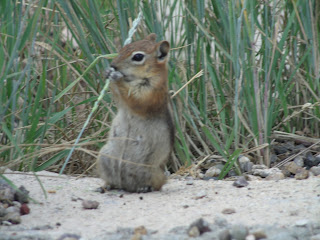
Even once I had the rest of my winter attirefigured out, the article of clothing that gave me the most trouble was gloves. I've probably gone through half a dozen pairs since I began cycling, and nothing worked quite the way I wanted it to. The big puffy gloves made it difficult to move my fingers and interferedwith shifting and braking, even if the design was supposedly cycling-specific. Also, I do photography work outdoors in the winter, and operating a camera with those is out of the question. Thermally-lined leather gloves can be just as warm while allowing for more mobility, but the leather gets stretched out and worn when used repeatedly on a bike. Wool gloves are hit and miss as far as warmth and some can be quite slippery on the handlebars. My salvation finally came in the form of these charcoal gray wool gloves by
DeFeet which I bought on a whim at a local bike shop. They may not look like much, but I love them.

The
DeFeet Duraglove is very densely knit, and warmer than any other thin wool gloves I've worn thus far. Once the temperature drops into the low 20s and I spend more than an hour outside I do begin to feel a chill in the finger tips, but above that they keep my hands perfectly warm (for comparison, I have a pair of stretchy-fleecy cross-country ski gloves rated for 20s temps that in reality give out in the low 30s). Aside from the warmth, the DeFeet gloves are form-fitting and stretchy, making it easy to operate both city bike and roadbike levers. And I can press all of my camera controls without removing them. They are not beautiful, but not horrendous looking either. They cost under $20. And the underside is covered with these silicone grippy things that ensure a firm hold on handlebars and camera equipment.

The Co-Habitant is also pleased with his
Ibex Knitty Gritty gloves that are similarly designed. He has a pair of both the full fingered and the fingerless versions and he uses both, depending on the temperature, for cycling and photography. The wool on these is softer and a bit chunkier than the wool of the
DeFeet gloves, but the idea is the same: stretchy wool for ease of movement, with silicone grips on the underside for a firm hold. The grippy bits here are in the form of little
Ibex logos, which I find very cute.

Unfortunately the
Ibex Knitty-Gritty gloves do not work for me, because even the smallest size is too big for my hands (beware, these run large), so I cannot compare them to my
DeFeetgloves directly.The prices are about the same. To my eye the
Ibexgloves are more attractive, but of course this says nothing about performance. The cuff on the
Ibex is a tad longer, but on both gloves the length is sufficient.The softer
Ibex wool is nice, but I am suspicious that the looser knit might translate into less warmth. Also, I have noticed a bit of pilling on the Co-Habitant's full-fingered gloves after a season's use, whereas the wool on my
DeFeet gloves seems less prone to this.

Sadly, I did experience wear and tear with my
DeFeet gloves: After 300+ miles of use on the bike, I wore a hole in the tip of the right index finger. While this is apparently a common problem to have with wool gloves, in my case I have to underscore that (1) I'd been wearing these on a roadbike and constantly pressing the ergo lever with my right hand, and (2) I have long fingernails, which no doubt contributed to this. Had I used them solely for transportation cycling on an upright bike, they probably would have been fine. In any case, I've now mended the hole (there is a special way to do this without destroying the articulated fingertip) and will see how long that lasts. If need be, I am willing to keep mending them and to buy a new pair every now and again, because as far as functionality and warmth go these gloves really work for me. I love the dense stretchy wool and the grippy underside; the versatility this style affords has made it my favourite winter cycling glove thus far.









 In the comments section of a post from a couple of days ago, I made a remark suggesting that bike shops have financial incentive to sell bikes and accessories separately, as opposed to bikes that do not need additional accessories. I have since received emails asking to expand on that, so let me give it a try.
In the comments section of a post from a couple of days ago, I made a remark suggesting that bike shops have financial incentive to sell bikes and accessories separately, as opposed to bikes that do not need additional accessories. I have since received emails asking to expand on that, so let me give it a try.

























